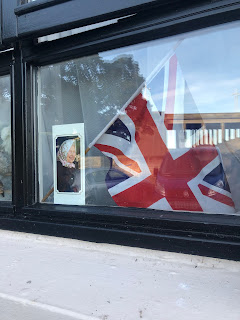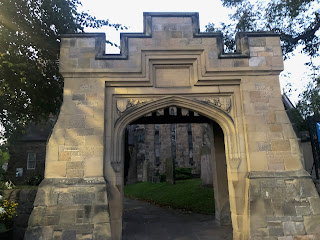This morning we were greeted with a glorious day in the picturesque town of Berwick upon Tweed. In case you couldn't guess, it is located on the Tweed River, and was actually famous in the past for its huge catch of Salmon which enter the town's waters via the North Sea for several months a year.
Marty went out early in the morning, to attempt to catch something in that river. He didn't have any bites, but he did take some awesome morning photos.
This bridge, referred to as the "old bridge", dates back to the mid 1600's. It was commissioned to be built by King James VI of Scotland, also known as King James I of England. He had traveled from Edinburgh to London for his coronation, and passed over the rickety old bridge as part of the journey. One of his first acts as King was to have a better bridge constructed for travel over the Tweed River. It's really kind of amazing that it has lasted all of these years. It has only one lane of automobile traffic, traveling in a single direction, along with wide sidewalks for pedestrians.
There is a more modern bridge, built in the 1920's, that I presume lets the traffic travel the opposite direction. But I can't say for sure as we did not drive on it.
While Marty was out fishing, I managed to capture a few morning photos myself, from the comfort of our room, which, conveniently, looked over the Tweed River.
Well, actually, it had a wall half way up the window, so I stood on a chair to take this photo.
I did forget that the chair swiveled, until it began to move as I positioned the camera, but, luckily, I managed to steady myself. I decided that it was probably best to stay on ground level.
It was built in the 1820s and continues to stand for passenger trains to pass from London to Edinburgh.
At night, the lights in the windows are lit up, and watching it travel along reminded me of a miniature train display. It was such a delightful experience to just sit in the room and watch the train at a distance.
At the base of the supports we watched a loon stand along the water's edge for quite some time. But we never saw him dive for a fish, which was probably a good thing, because I didn't need Marty deciding that he wanted to go back out and fish again.
The sites coming back to the room were unique. The wreath certainly seemed appropriate.
and I just loved the streets with the colorful rooftops.
I spotted this touching memorial displayed in a little window along the walkway.
We have noted that every flag is at half mast, and the B&B proprietor was wearing a black mourning band on his left forearm. Although we are on holiday, there are signs all around us showing just how loved this woman was by her people.
We both wished that we could have stayed in this lovely town longer, but the woman only had one night available when I was booking, so we had no choice but to move on.
The first planned stop was Washington Old Hall, located in Washington, just outside of Newcastle upon Tyne. We were driving along the A1 when I noticed a brown designated tourism sign that said, "Hardy's Fishing Tackle Museum" and it was pointing to the left at the next exit. Luckily for me, Marty didn't see it until it was too late to turn. But we both did get quite a chuckle out of the fact that such a museum exists.
By the way, if you are interested, it's along the A1, just north of Alnwick.
Traffic was super congested today, as it seems that every major road that goes through Newcastle (and there are several) was under some kind of construction. So, it took awhile but we finally arrived at Washington Old Hall, just in time for the guided talk.
Now, if you are thinking that this manor house is in somehow connected with George Washington, then you are correct.
However, the connection isn't as exciting as one might suppose. It is the ancestral home of the Washington family built in the mid 1300s. But it passed through many family members, became a tenement house for mining families, and was finally rescued from demolition by a man named Fred Hill.
The structure is original, with some additions over the years. But the contents of the house reflect pieces from the 17th century time period as there are no original items to display.
The outside of the building is quite grand
and the gardens were full of little surprises.
Upstairs, a musical duo were playing some lovely tunes on various instruments. The melodies echoed through the house, and we really enjoyed listening to this exceptionally talented couple.
We had a wee chat regarding one of the pieces that they had played, Ashokin Farewell, and it was mentioned that this had been a favorite from the past, with Marty accompanying two of our children on guitar while they played the violin part. The next thing I knew, Marty had a guitar in his hands and the duo had become a trio!
It really was all quite fun.
Unfortunately, a weather front had moved in, so the bright clear skies were no longer set for viewing.
Although it did appear that there was much better luck just a bit north of where we were.
Of course, a little adverse weather wasn't going to affect us!
The light house was commissioned in 1871 along the coast, as there had been numerous ships that had sunk due to rocks hidden underground near the shoreline.
I found it amazing to see that the original equipment to work the lighthouse was still held in perfect condition.
We made the trek up the 75 or so steps to the top, the last set being more like climbing a ladder.

We were right up in the room where the lights are held behind the rotating lenses that would have been the warning beacon for any ships in the area.
I learned that every lighthouse as a unique foghorn sound, and this one was in the key of F. Now, I have no idea how someone listening would know what key a foghorn was in. Luckily, it also had a distinct timing pattern, as did the flashing of the lenses, which were also unique to each lighthouse.
This way, the ships would know where they were located when they heard the foghorn (if it was foggy....and this is northern England....so you know that happened frequently) and they saw the timing of the lights in the lighthouse.
The lighthouse keeper's cottage had a list of letters associated with weather conditions, which I found to be quite amusing.
Today, we experienced B, C, D, M, O and Z, with a little G.
By the time we left, it looked like B was well on its way!
Once more, Marty drove through the congestion of Newcastle, making our way west to a little village called Dilston, that is southeast of Corbridge.
Well, actually, I'm not sure that there is a village called Dilston. I can say that we are staying at the Dilston Mill, which is a former mill located on quiet stream. It was a bit disconcerting when we turned into a tiny lane that said no cars were permitted to travel further. But we decided to venture onward, and, sure enough, there was the mill. We were greeted by Susan, the owner, given a tour of our rooms, and we headed back into Corbridge for dinner as I had secured reservations prior to leaving.
Susan had given us the heads up on parking on this side of the river Tyne, then walking across the bridge into the village.
It was the perfect night to do so, as the weather had cleared (or, perhaps it never did rain here....who knows?). After a fabulous dinner at an Italian Restaurant, we took a quick jaunt around the village before it became too dark. Isn't it just delightful?
The sun was setting as we headed back to the car park.
I'd say that view was the perfect ending to a fabulous day, wouldn't you?







































👏👏❤️
ReplyDelete